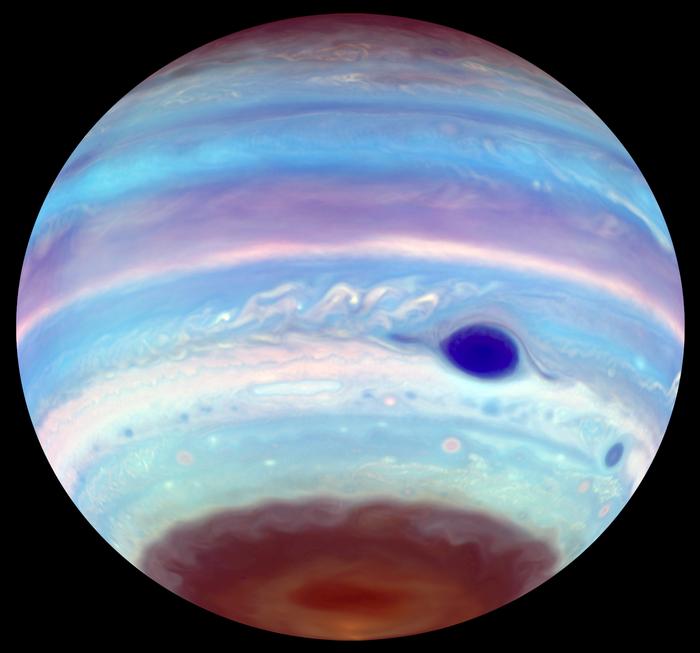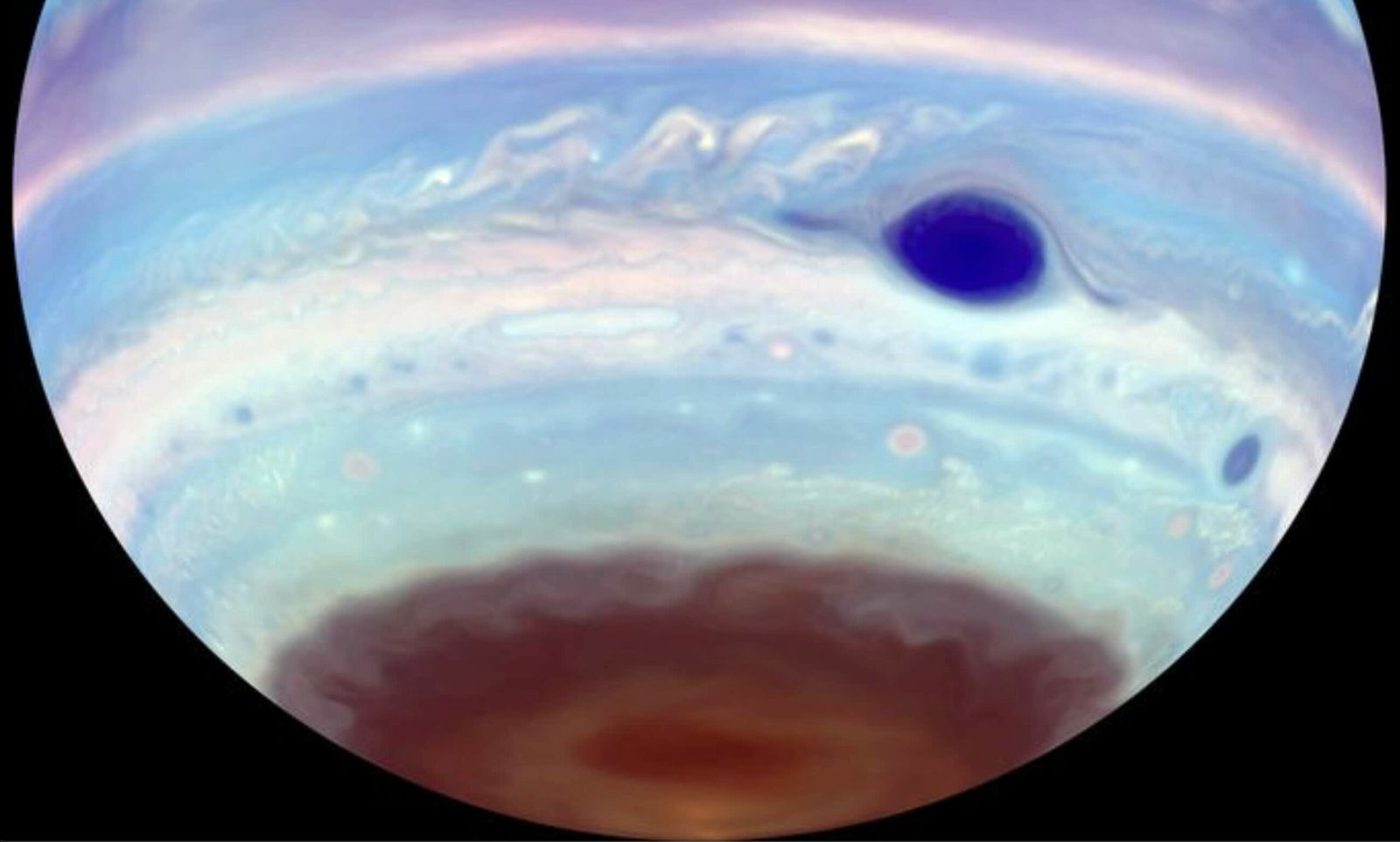Jupiter’s perpetual storm, the Great Red Spot, has been a curiosity for some time, but now researchers have discovered similar short-lived spots that may be generated by magnetic tornadoes among the planet’s unusual features.
Astronomers from the University of California, Berkley, discovered the strange hazy dots at Jupiter’s poles. Only perceptible at ultraviolent wavelengths, the spots are oval in shape and roughly the size of the Earth.
Mystery at Jupiter’s Poles
Between 2015 and 2022, NASA’s Hubble Space Telescope often captured the dark spots, with annual images displayed a dark spot three-quarters of the time at the South Pole and an eighth at the North. These mysterious ovals are embedded in the haze layers over the poles in Jupiter’s stratosphere.
As Earth has its auroras, commonly known as the Northern and Southern Lights, so does Jupiter. The strange dark spots always form just below these polar auroral zones. NASA’s Hubble Space Telescope registers the spots as dark due to their absorption of more UV than their surroundings.


While the auroras may remind us of Earth, Jupiter differs significantly from our home planet. Instead of being a rocky ball in space, it is a gas giant composed chiefly of hydrogen and helium and is 11 times Earth’s diameter. The dark splotches suggest something strange occurs much deeper in Jupiter’s atmosphere than where the auroras are produced on Earth.
Uncovering Magnetic tornadoes on Jupiter
In the late 1990s, Hubble, shortly followed by the Cassini space probe in 2000, first recorded the unusual patches. At the time, astronomers paid little attention to the phenomenon. When Troy Tsubota, an undergraduate student at UC Berkeley, noticed their frequent occurrence at Jupiter’s south pole in recent Hubble images, it was the first time anyone paid significant attention. Joined by senior author Michael Wong of UC Berkley’s Space Sciences Laboratory, Tsubota counted eight occurrences of the spots in imagery between 1994 and 2022. Yet, only two of 25 maps of Jupiter’s north pole included the dark ovals.
The Hubble images were primarily the work of the Outer Planet Atmospheres Legacy (OPAL) project. OPAL’s director, NASA scientist Amy Simon, further joined the team’s work for the paper. Under her leadership, OPAL astronomers observe Jupiter, Saturn, Uranus, and Neptune yearly to record their atmospheric dynamics and changes.
“In the first two months, we realized these OPAL images were like a gold mine, in some sense, and I very quickly was able to construct this analysis pipeline and send all the images through to see what we get,” Tsubota explained. “That’s when we realized we could do some good science and real data analysis and start talking with collaborators about why these show up.”
Pursuing Jupiter’s Magnetic tornados
On the trail of odd hazes, Wong and Tsubota sought out and consulted two planetary atmosphere experts about what was in the Hubble images. These experts were Northumbria University in Newcastle-upon-Tyne’s Tom Stallard and US Santa Cruz’s Xi Zhang. Stallard proposed a magnetic storm hypothesis to account for the images.
The Northumbria University Professor theorized that Jupiter’s magnetic field lines encountered friction between the ionosphere and hot, ionized plasma emanating from Jupiter’s volcanic moon Io. Stallard’s earlier work detected a spinning motion in Jupiter’s ionosphere that he believes may be related to a vortex created by the friction, stirring the dark ovals from above, similar to a tornado impacting the dusty ground.
Zhang performed the radiative transfer calculation and quantified the enhanced haze level needed to explain the oval’s darkness. Additionally, he worked on identifying potential causes for the elevated haze concentrations.
“The haze in the dark ovals is 50 times thicker than the typical concentration,” said Zhang, “which suggests it likely forms due to swirling vortex dynamics rather than chemical reactions triggered by high-energy particles from the upper atmosphere. Our observations showed that the timing and location of these energetic particles do not correlate with the appearance of the dark ovals.”
OPAL Keeps An Eye Out
Tsubota and Wong’s quest for answers fulfills OPAL’s promise to uncover how atmospheres on other planets may differ from Earth. However, more work remains to understand atmospheric behaviors fully. None of the scientists could determine if the magnetic tornadoes generated the haze or pulled it up from below. Still, the work lays the foundation for what scientists can expect to find in the cosmos and at home.
“Studying connections between different atmospheric layers is very important for all planets, whether it’s an exoplanet, Jupiter or Earth,” Wong commented. “We see evidence for a process connecting everything in the Jupiter system, from the interior dynamo to the satellites and their plasma torii to the ionosphere to the stratospheric hazes. Finding these examples helps us to understand the planet as a whole.”
The paper “UV-Dark Polar Ovals on Jupiter as Tracers of Magnetosphere–Atmosphere Connections” appeared on November 26, 2024 in the Nature Astronomy.
Ryan Whalen covers science and technology for The Debrief. He holds a BA in History and a Master of Library and Information Science with a certificate in Data Science. He can be contacted at ryan@thedebrief.org, and follow him on Twitter @mdntwvlf.

